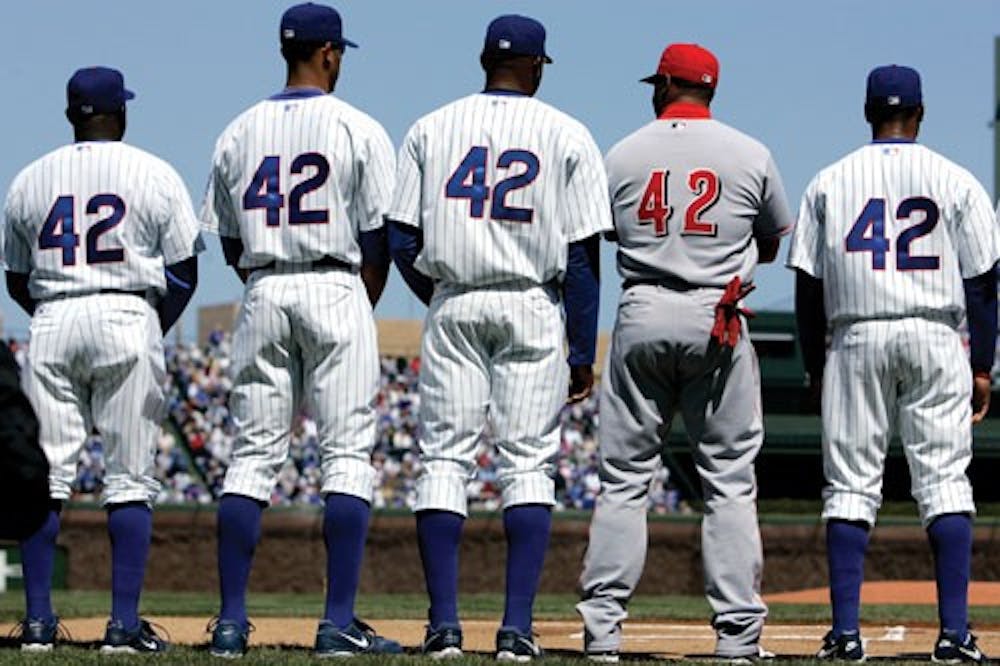NEW YORK – Rachel Robinson still has vivid memories of April 15, 1947, when her husband changed America forever.\nAs Jackie Robinson was getting ready to break baseball’s color barrier with the Brooklyn Dodgers, Rachel was hustling to get to Ebbets Field in time to see it.\nShe waited a long time for a taxi because drivers routinely passed up black passengers. She worried their baby, Jackie Jr., would be cold because she had dressed him in spring clothes. And she stopped at a hot dog stand in the ballpark, where a vendor was kind enough to heat up the boy’s bottle.\n“It was an exciting, exhilarating time – but it also was a stressful time,” Rachel Robinson said.\nReform is rarely a breeze. Sustaining a legacy can be even more difficult.\nAs Major League Baseball celebrated the 60th anniversary of Robinson’s landmark achievement Sunday, there are growing concerns about the sport’s racial makeup.\nOnly 8.4 percent of big league players last season were black – the lowest number in at least two decades. In 1995, 19 percent of major leaguers were black, according to Richard Lapchick, director of the University of Central Florida’s Institute for Diversity and Ethics in Sports.\n“Obviously, he would not be satisfied with where we are now,” Rachel Robinson said, referring to the man she still calls Jack. “He would be disappointed, because he felt we were on the way toward some lasting change.”\nHas baseball betrayed Jackie Robinson?\n“That’s what it seems like to me – that all the work he’s done is almost for nothing,” Minnesota Twins center fielder Torii Hunter said. “Because look where we are. We should be progressing. We’re regressing.”\nTo be fair, baseball is undeniably diverse in certain areas. More and more players are coming from Asia and especially Latin America. According to Lapchick, 29.4 percent of players last season were Latino and 2.4 percent were Asian. That means 40.5 percent were minorities, just below baseball’s all-time high of 42 percent in 1997.\nWhen evaluating opportunities for minorities in sports, does it matter which minorities?\nIt does to Jimmie Lee Solomon, executive vice president of baseball operations in the commissioner’s office and an architect of this spring’s inaugural Civil Rights Game. His concern is baseball could reach a point where it’s too late to stem the tide of indifference among black fans.\n“Baseball more than any other sport has a heritage that it links with African-Americans and African-American participation,” said Solomon, who is black. “We don’t want to lose that heritage, that linkage.\n“But there are economic reasons as well,” he added. “The African-American buying power is significant. To ignore African-American players and fans is really shortsighted from a business standpoint.”\nThe growing disinterest already has affected Robinson’s legacy, Hunter said.\n“Nowadays, if you talk about Jackie Robinson, or Hank Aaron, a lot of black kids don’t even know who he is. That’s pretty sad,” Hunter said. “A lot of parents, they’re my age and they don’t know who they are. So how are they going to teach their kids? Pretty much, it’s at home. A lot of kids don’t even know how important Jackie Robinson is to our history.”\nHall of Famer Joe Morgan said that’s unacceptable.\n“If you’re an African-American, you should know what he did,” Morgan said.\n– AP Baseball Writer Ronald Blum in New York; AP Sports Writers Dave Campbell and Jon Krawczynski in Minneapolis; Stephen Hawkins in Arlington, Texas; and Howard Fendrich in Washington, D.C. contributed to this report.
Players celebrate legacy of Jackie Robinson
Hall of Famer broke color barrier 60 years ago

Get stories like this in your inbox
Subscribe





